The Cities We Want: Resilient, Sustainable, and Livable
Resilience is the word of the decade, as sustainability was in previous decades. No doubt, our view of the kind and quality of cities we as societies want to build will continue to evolve and inspire a new descriptive goal. Surely we have not lost our desire for sustainable cities, with footprints we can globally and locally afford, even though our focus has rightly been on resilience, after what seems like a relentless drum beat of natural disasters around the world.
It speaks to the question: what is the city we want to create in the future? What is the city in which we want to live? Certainly that city is sustainable, since we want our cities to balance consumption and inputs to make a footprint that can last into the future. Certainly it is resilient, so our cities are still in existence after the next 100-year storm, now apparently due every few years.
And yet: as we build this vision we know that cities must also be livable. Indeed, we must view livability as the third indispensible—and arguably most important—leg supporting the cities of our dreams: resilient + sustainable + livable.
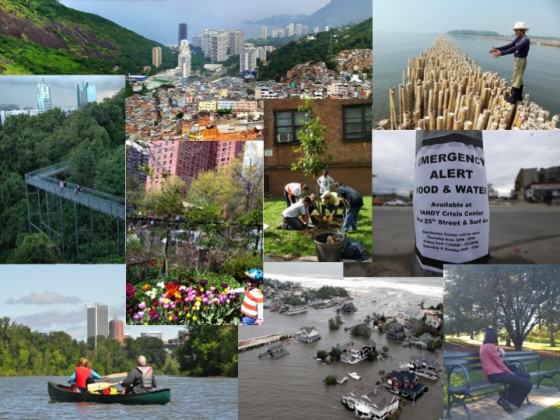
We can imagine resilient cities—especially cities that are made so through extraordinary and expensive works of grey infrastructure—that are not sustainable from the point of view of energy consumption, food security, economy, or other resources. They perhaps are not even resilient, but rather resistant, in the sense that they repel the shock rather than absorb and bend it to.
We can imagine livable cities that are neither resilient nor sustainable.
And, it is easy to imagine resilient and sustainable cities that are not livable—and so are not truly sustainable.
Where does your city, your neighborhood, fall in the three dimensions of resilience, sustainability and livability?
The point is that we must conceive and build our urban areas based on a vision of the future that creates cities that are resilient + sustainable + livable. No one of these is sufficient for our dream cities of the future. It is self-preservative, and indeed morally right to do so. Yet we often pursue these three elements on independent tracks, with separate government agencies pursuing one or another and NGOs and community organizations devoted to a single track. Of course, many cities around the world don't really have the resources to make progress in any of the three.
How do we advance? I'd like to present six challenges about a resilience + sustainability + livability continuum, clarity about which could help us get there.
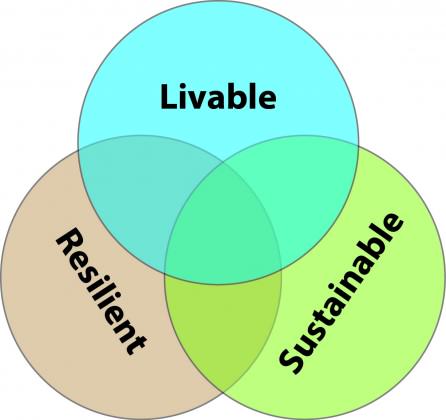
Resilience to what? Resilience for whom?
Everyone can agree that "resilience" is a good thing—but an operation definition is really about difficult choices. We have to be specific about the choices involved in increased resilience, first by asking what stress to want to be resilient to. Storm surge? Heat? Drought? Some of the things we could do to create more resilient cities are stuff we should do anyway. Other choices involve sacrifices, are terrible, difficult, or require enormous trade-offs. As societies we have to be explicit about these trade-offs—about their consequences.
When we are vague about what we mean by resilience, allowing it to stay in the realm of metaphor, we avoid having to face and discuss the possibility that there are real trade offs involved—that such choices may produce winners and losers.
This challenge is so rich in part because each of these words have many definitions, ones that vary by context and profession and community, and are vivid in the eyes of the beholders. It is why the words are so easily left in the realm of metaphor.
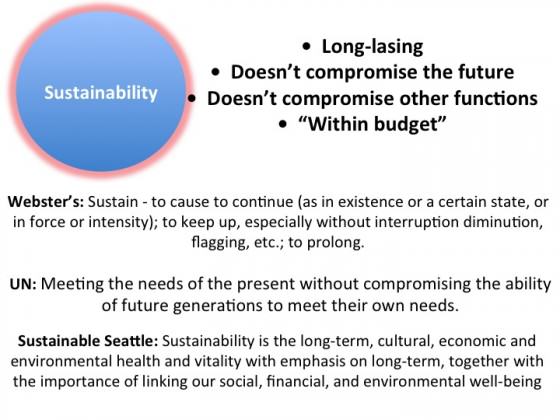
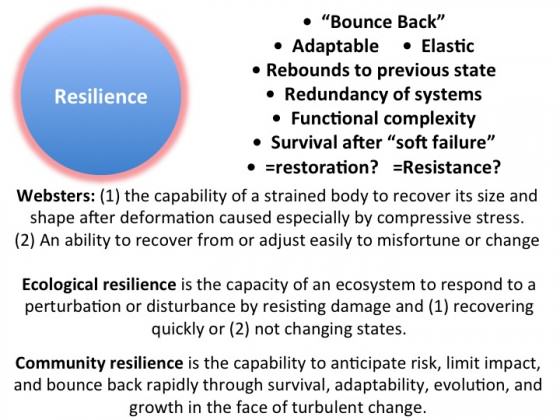
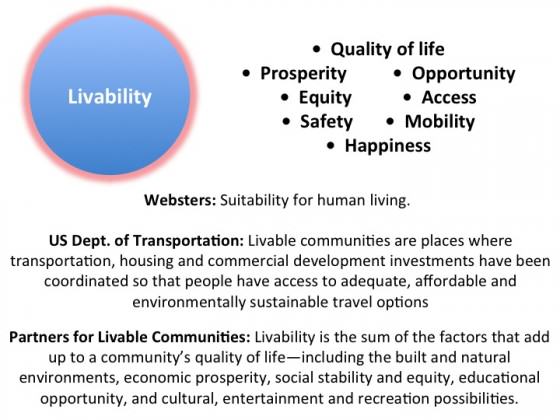
The classic definitions of ecological resilience and personal resilience both focus on idea that, in the face of stress, we bend but do not break—that our systems are elastic enough to deform and absorb the stress and then "bounce back" to the former state. At some level, though, high stress bumps the system to a new state, or new equilibrium—one we may not like. Resilient systems are those that can take a lot of stress before they are bumped to a new state. Marina Alberti wrote about this on this site.
New Yorkers exhibited a lot of personal and psychological resilience after Hurricane Sandy—they picked themselves up and started again, often rebuilding their lives in the same spot. This is true all over: people are resilient in the face of hard times.
However, cycles of damage and rebuilding is not ecological or system resilience. Restoration is an act of the community and can require great resources. We as a society may choose to rebuild, but it isn't ecological or system resilience (although certainly suggests social resilience). Resilient systems are those, by nature of their design and function, that absorb shocks and at some point return to their original state unchanged. This is why green infrastructure is so often thought of as key to urban resilience: green infrastructure, both built and natural, absorbs the water, calms the waves, moderates the wind and heat, and bounces back. For cities that don't have the money to build expensive grey structures to resist, this choice is crucial.
Challenge #3: Can we contribute to communities and social movements that include and engage people where they live?
Engagement is key at every level. Street trees everywhere have a known set of biophysical benefits, from storm water capture to air-cooling and biodiversity habitat. But to me perhaps the greatest brilliance of concerted tree planting projects such as Million Trees NYC and others in cities in the U.S., Europe, and around the world—perhaps unexpected and uncharted by the original creators of these programs—is the community building they engender through stewardship activities. These benefits are now well known and thoroughly part of such programs. For example, GreenPop in Cape town reports on their website 18,000 trees planted, 3,000 volunteers, and 100,000 people benefitting from a program that is just a couple of years old.
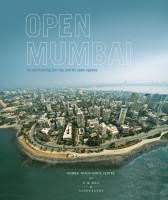
For example, architect and activist PK Das leads such an effort in Mumbai. Nallahs are open waterways that have largely functioned as open sewers that run through slums and other neighborhoods. Das' Open Mumbai project blues these waterways, greens their edges, and opens their banks to people. The designers and stewards of these new Nallahs are the people who live there. This is an immense benefit in a city of 24 million with less than 1 square meter of open space per resident.
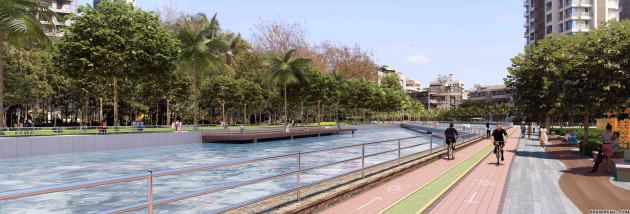
A Nallah in Mumbai before and (rendered) after. Credit: PK Das
Challenge #4: Mindfully create mosaics of communities and design elements that together add up to resilience + sustainability + livability?
If there is one class of design element that embodies all three of these values—resilience + sustainability + livability—it is a community garden. Gardens contribute to a city's resilience to storms by capturing water that otherwise might contribute to flooding and overloaded sewer systems. They produce food that otherwise would be imported from elsewhere. They are typically places of beauty where people gather and strengthen a community's sense of identify and cohesion.

Photo: David Maddox
Of course not every type of useful infrastructure or project functions at all three levels. But areas—neighborhoods, zones, or watersheds, etc.—must have multiple projects that add up to all these functions. Paul Downton, in a previous TNOC blog post, spoke of fractals: the idea that each minimum operational geographic scale (e.g., a neighborhood) should have all desirable elements of nature and infrastructure represented. The same is true in this context. Every neighborhood should be planned with all of the resilience + sustainability + livability elements: community gardens, parks, street trees, bioswales, mixed transportation, storm surge barriers (if on the coast), walkable streets, and so on. Green and functional infrasttucture, justly delivered.
This point circles back to Challenge #1: resilience for whom? If every zone or neighborhood is planned with a complete set of resilience + sustainable + livable values, then perhaps we are less likely to find that projects that create more resilience for one set of people means less resilience for another.
Challenge #5: What do different types of cities have to say to each other?
There are a few handfuls of cities around the world with the resources to create or buy the resources, structures, and experts they need to solve their resilience, sustainability and livability challenges. But there are, depending on how you count, over 3,000 cities in the world with more than 150,000 inhabitants.
How can people in these cities find the information and inspiration they need to effect positive urban outcomes and green solutions for resilience, sustainability and livability? Cities often have more problems—and solutions—in common with each other, even across political boundaries, than they do with rural areas nearby. International meetings and paid consultants are beyond the reach of most communities. How can they share knowledge and best practices? How can they learn what works well in other cities?
Solutions to urban problems ultimately must be adapted and implemented locally. Because urban problems often have roots in global issues, and the problems are often shared widely, an accessible and practical idea and knowledge-sharing platform is critical. This platform needs to be person to person so that thinkers and doers can share and learn, so knowledge can propagate and spread. Local solutions can thereby be shared globally and then re-localized, in new places. TNOC and partners are planning such a platform.
Challenge #6: Can we create a unified definition of resilience + sustainability + livability?
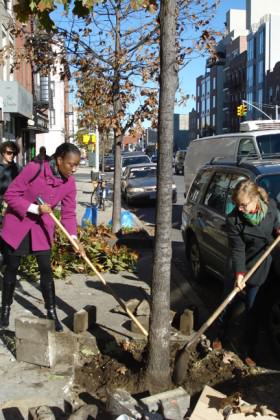
Photo: MillionTreesNYC
In essence, I believe the key is in operationalizing a resilience-sustainability-livability connection—taking it out of pure metaphor. In so many individual places and programs this is happening already, and these triumphs needs to be celebrated and multiplied. Since there are increasing numbers of grass roots examples, real progress may accelerate when, as the people lead, networks spread and the governments follow in supporting the local actions and projects.
Many of the natural features that provide buffer and shelter (i.e., resilience) are also features that improve quality of life, health, have economic value, etc.: parks, street trees, bioswales, gardens, green roofs, etc. Such natural features reduce the economic costs of catastrophic change, certainly, but their benefits extend well beyond, into the very idea of the kind of city we want to create, the city that we all want to live in.
A closing idea from Buzz Holling
One key [to resilience] is maybe best captured by the word "hope".
Although Buzz Holling was an original elucidator of the ecological resilience concept, here he used a word that is fundamentally a human concept. What does it mean to hope? At its most basic, it is a desire for and the belief in a certain good outcome.
We hope for life. We hope for a certain stability without destructive change. We hope for a future that is at least as good as the present.
We hope to reside in cities that are resilient. Are sustainable. And above all, livable.
We deserve, and with the right choices, can have all three.
David Maddox
New York City

